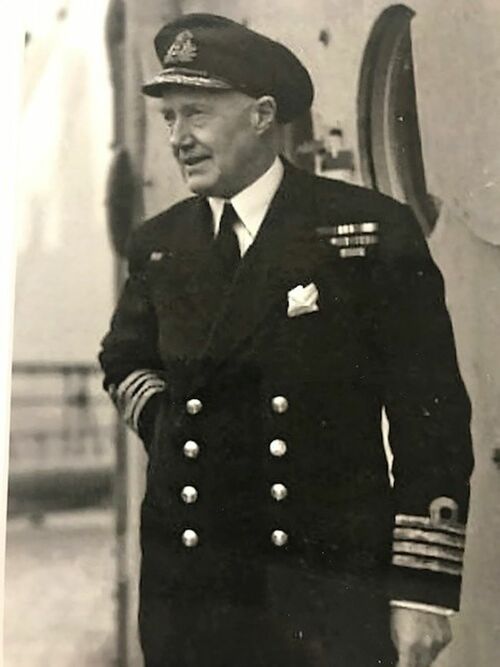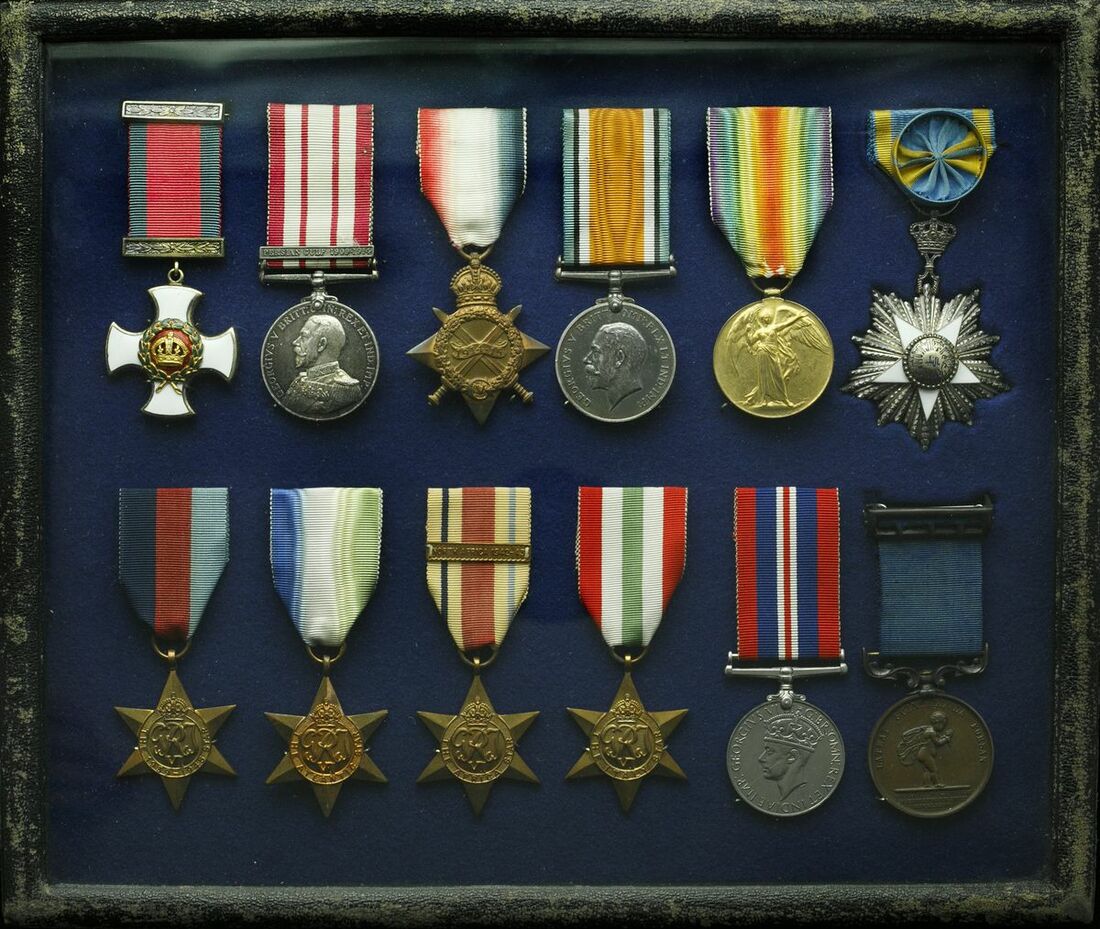Auction: 23003 - Orders, Decorations and Medals
Lot: 233
A Second World War 'Operation Aerial 1940' Submariners D.S.O. group of twelve awarded to Captain R. L. Hamer, Royal Navy, who was also 'mentioned' for the landings in North Africa
Distinguished Service Order, G.VI.R, reverse officially dated '1940'; Naval General Service 1915-62, 1 clasp, Persian Gulf 1910-14 (Lieut. Commr., R. L. Hamer, R.N. H.M.S. Swiftsure.); 1914-15 Star (Flag. Lt. Commr. R. L. Hamer, R.N.); British War and Victory Medals (Commr R. L. Hamer. R.N.); 1939-1945 Star; Atlantic Star; Africa Star clasp, North Africa 1942-43; Italy Star; War Medal 1939-45; Egypt, Kingdom, Order of the Nile, 4th Class breast Badge in silver-gilt, silver and enamel, by Lattes; Royal Humane Society Bronze Medal (Commdr R. L. Hamer R.N., 14 Feb 1920), housed in a glazed display frame, extremely fine (12)
D.S.O. London Gazette 3 December 1940.
For courage and resource in successful attacks on Enemy Submarines.
Egypt, Order of the Nile Officer (4th Class) London Gazette 29 October 1918.
Richard Lloyd Hamer was born on 13 January 1884 at llanyblodwel, Shropshire and was educated at Stubbington house. He joined the Royal Navy Training Ship Britannia on 15 September 1898. Appointed Midshipman on 15 July 1900 and promoted to Sub-Lieutenant 15 July 1903 with H.M.S. Myrmidon. Further advanced Lieutenant with her on 1 December 1905 he joined the company of Cynthia the next year.
Going ashore in 1908 Hamer undertook a number of courses and special appointments, being promoted Lieutenant-Commander on 31 December 1911. His first independent command was the destroyer Kestrel on 1 April 1913, a posted he occupied until 22 July 1913 before being appointed Flag Lieutenant-Commander of H.M.S. Swiftsure. His commander here was, Rear Admiral C. H. Pierce who was made Commander-in-Chief East Indies on the same day. Hamer married the Rear-Admiral's daughter, Blanch Carrina Feilden Pierce, at Bombay Cathedral on 14 November 1914.
H.M.S. Swiftsure in the Great War
At the time of his appointment Rear-Admiral Pierse had a very small squadron, containing Swiftsure, the cruisers Dartmouth and Fox and three sloops, one of which had been detached to serve in the Persian Gulf while another been sent to Hong Kong to provide a crew for Triumph. At the start of the war Peirse had first though to go to Singapore to defend against von Spee's East Asian Squadron, but on 6 August he was ordered west to patrol the route from Colombo to Aden against a possible threat from the German raider Konigsberg.
The destruction of the Emden and the inactivity of the Konigsberg freed the Swiftsure from escort duties, and in November she was posted to the Suez Canal. The defence of the Canal had been added to Admiral Pierse's duties, and on 1 December he arrived at Port Said to raise his flag.
With the Ottoman attack on the Suez Canal on 3-4 February 1915, Swiftsure was assigned at a station just north of Kantara. This area was the target of a subsidiary Turkish attack, which was soon repulsed with Swiftsure fired at the retreating Turks until 13:00 hours when they were finally out of range.
She was allocated to the fleet at the Dardanelles early in 1915- after the Euryalus arrived to take over as Pierse's flagship. Her first action here came on 2 March, when she entered the straits to attack the Turkish forts, later both Swiftsure and Triumph were detached to attack the forts defending the port of. The forts at Smyrna proved no more vulnerable to naval gunnery than those at the Dardanelles, but the Turks then sank blockships in the harbour entrance. This did at least prevent its use as a submarines base for the Germans.
Swiftsure and the Triumph returned to the Dardanelles to take part in the failed attempt to force the narrows on 18 March. During the Gallipoli landings on 25 April Swiftsure was the flagship of Admiral Nicholson, covering the attacks at the tip of the peninsula. Her primary role was to bombard the Turkish positions around "W" beach.
Hamer completed his time on Swiftsure on 31 December 1915, and then went to command Vivid from 5 March 1916 - 8 September 1916 and then to the destroyer Rowena from 13 September 1916.
Rowena was an R Class destroyer and part of the Fifteenth Destroyer Flotilla. Having held command of her for two years Hamer was the subject of a Court of Enquiry into the collision of Rigorous and Rowena in October 1918. He was informed by Admiral Beatty that 'he hazarded the ships and that the method employed in obtaining the mails was un-seamanlike' and warned to be 'more careful in the future'. This however was not to be the last time Hamer was accused of hazarding his ship.
Inter-War
Appointed to the command of Tempes on 7 July 1919 and Stonehenge in August he was awarded his Royal Humane Society Medal while with the later. Stationed at Flensburg on 12 May 1920 he saved a man from drowning on 12 May 1920. Relinquishing command of Stonehenge on 2 February 1920 he took up the position of Naval Assistant Secretary of the Committee of Imperial Defence on 23 February. Hamer's service record stating this being for "Special Service" inside the Admiralty (War Cabinet Secretariat).
Leaving the postion on 1 November 1921 he saw service with Torch and Tuscan before being place on the retired list on 2 February 1923. Having retired Hamer served on the Staff of the Royal National Life Boat Institution from 1925. Promoted Captain (Retired List) on 13 Janaury 1929 he was appointed Deputy Chief Inspector, R.N.L.I. in 1930.
Operation Aerial 1940
Recalled to active service at the outbreak of the Second World War, he was attached to the 88th Anti-Submarine Group, serving on H.M. Armed Yacht Viva II.
The 88th Anti-Submarine Group formed part of Western Approaches Command, Liverpool Sub Command at Birkenhead under Commander H. S. M. Herbert. Viva II was involved in Operation Aerial, the withdrawal of allied troops from Western France.
During this operation Viva II's role was to patrol down the coast and find which towns had troops to evacuate and which were in Enemy Hands. She had a submarine contact on 21 June 1940 and, doubtless mindful of the number of troop ships operating in the area, Viva II attacked. Several awards were made to the ship for their attack on the u-boat with Captain Hamer receiving the D.S.O. later invested on 22 September 1944.
H.M.S. Bulolo
Hamer left Viva II to take the command of the experimental Landing Ship Headquarters or L.S.H., H.M.S. Bulolo in October 1940. The concept for a central communications ship to assist in amphibious landings was taken up by Combined Operations Heaquarters. Keen to try it Mountbatten cajoled the Ministry of War Transport into providing him with a vessel to put the embryonic idea into practice. Bulolo had previously been an Australian Passenger ship of 6,400 tons, it was stripped of non essential equipment and refitted with communications equipment and control room facilities. The work was completed in the summer of 1942 by which time the conversion of a second L.S.H. ship, H.M.S. Largs, was underway.
The following is an account by Edward (Ted) Pierce who served on HMS Bulolo:
'Having joined up in November 1941, drafted first to HMS Gelndower (Butlins Camp, Pwllheli) and within a few weeks to HMS Valkyrie (Isle of Man), I was destined to become one of the early trainees in naval Radio Direction Finding (RDF), the term Radar hadn't come into use yet. Six weeks later, by now an Able Seaman RDF, I was drafted with instructions to join HMS Bulolo, at that time lying in Royal Albert Dock, London, undergoing a fundamental refit, transforming her from her former role as an armed merchant cruiser into what was to be the first ever Combined Ops HQ ship.'
Bulolo was ready for sea trials off the coast of Scotland by June 1941 during which time Mountbatten came to visit and inspect. Before long, signals personnel from Army and Royal Air Force units joined the ship's company and along with additional Naval officers and ratings. The R.D.F. ratings were responsible to a Canadian green-stripe sub-lieutenant and a leading seaman R.D.F. (Tom O'Carroll), drafted from a Flower Class corvette where he had earned himself a D.S.M. in recognition for detecting a U-Boat, leading to its sinking.
The coming months were spent in preparation for Operation Torch, the North African landings, where she served as flagship of Admiral Sir Harold Burrough, destined for Oran and Algiers. His passengers included high ranking officers from all three services, both British and American, including General Ryder and General Mark Clark.
The voyage was uneventful at first, until- soon after passing undetected through the strait of Gibraltar- enemy air attacks began interfering with the convoys progress. Nevertheless, landings were successfully achieved and in due time Bulolo was able to proceed, as planned, with imperial dignity, into Algiers harbour. Unfortunately, as Commander Anthony Kimmins reported in his BBC broadcast that night:
'while approaching the harbour that morning, Bulolo had been heavily dive-bombed by Hun aircraft. A near miss had thrown the telegraph indicators from the bridge to the engine room out of action. As there had been no occasion to use the telegraph between then and coming into harbour there was no reason to suspect they had been damaged. Now, as the captain rang down 'Stop-Half astern -Full astern' the engineers below were blissfully unaware that they had been given any orders. Luckily a sandbank and some rafts broke the impact but Bulolo hit the concrete jetty a tremendous crack before finally coming to rest. having visited Algiers a couple of times since then I can testify that the dent in the jetty wall is still there!'
The following days Bulolo was the centre of activity for the initial political and military negotiations with the Vichy French authorities and of course the vital communications link with the American forces in Casablanca.
After four weeks alongside in Algiers she returned to the U.K. in time for Christmas leave. But her North African duty was not quite over yet. The Casablanca conference, when Churchill and Roosevelt were to discuss plans for the next stage in the war, was scheduled for early January. Churchill knew that he would have problems persuading Roosevelt and his staff to adopt his favoured approach for continuing the Mediterranean campaign, which he knew the Americans viewed as simply delaying the main invasion of Europe. I quote from an account of these events by Rick Atkinson in his bookAn Army At Dawn, which states:
'To help build his case, Churchill had ordered Bulolo to attend at Casablanca. With its war room full of planning studios bound in red leather dispatch folders, Bulolo symbolised the British empire's formidable bureaucratic firepower.'
Here the British chiefs would lobby their American counterparts, all issues would be discussed fully, and the relentless British logic would win through. Those red leather folders would reveal 'wondrously precise studies and statistics' in support of Churchill's strategic arguments.
Hamer was Court Martialed in respect to hazarding Bulolo on 10 September 1943:'Two charges (a) Hazarding (b) Suffering HMS Bulolo bo be hazarded. Both charges were proved. Officer to be reprimanded.'As a result of the Court Martial he was appointed to a land based command. Specifically, Naval Officer-in-Charge Thurso- H.M.S. Prosperine- on 7 March 1944- July 1945. Dispersed on 29 November 1945 he was released from the Fleet on 24 January 1946. The following day Hamer reverted to the Retired List, he died just six years later on the 16 December 1951.
Subject to 20% VAT on Buyer’s Premium. For more information please view Terms and Conditions for Buyers.
Sold for
£2,700
Starting price
£2500







